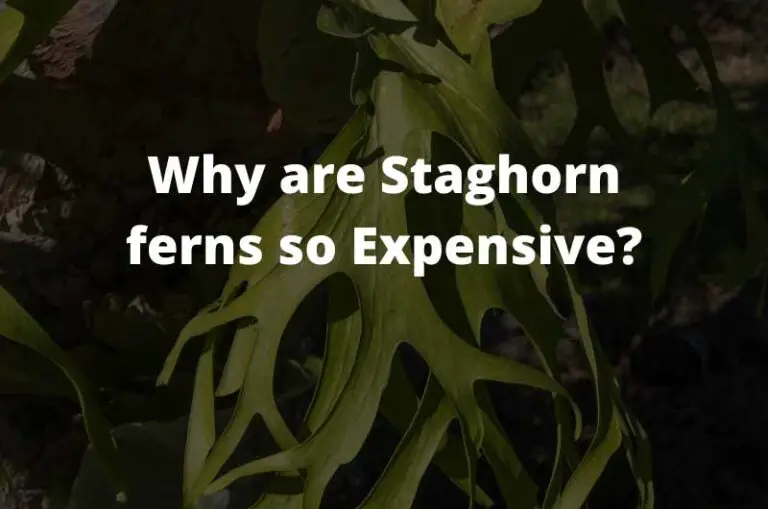Oh boy, do I have some fern-tastic news for you! Who knew that a plant could be so expensive? I mean, seriously, have you seen the prices of Staghorn ferns lately? It's enough to make your eyes water.
What's the Deal with Staghorn Ferns?
Well, for starters, they're pretty unique. Staghorn ferns (officially known as Platycerium) are epiphytic plants, meaning they don't grow in soil. Instead, they grow on the sides of trees or other surfaces, where they absorb nutrients and moisture from the air.
But that's not all that makes these ferns special. Staghorn ferns have two different types of fronds (or leaves). The first type, called the basal fronds, are the round, flat leaves that grow outwards like a regular fern. But it's the second type of fronds that really give these plants their distinctive look.
The second type of fronds are the antler-like, hanging fronds that grow downwards. These fronds are responsible for collecting moisture and nutrients from the air, which is why they're so important to the plant's survival.
So, Why Are They So Expensive?
Well, for starters, these ferns can be pretty difficult to grow. They require a high level of humidity, as well as bright, indirect sunlight. They also need to be mounted on a surface (like a piece of wood or a wire mesh) in order to mimic their natural growing environment.
But besides the practical difficulties of growing Staghorn ferns, there's also a certain level of demand that's driving up their prices.
For one thing, these ferns are pretty trendy right now. They've become popular as decorative items in homes and offices, and they're often used in interior design to add a touch of greenery to a space.
But there's also a certain level of exclusivity that comes with owning a Staghorn fern. Because they're difficult to grow, not everyone can have one. And because they're fairly rare (especially the larger, more impressive specimens), they've become something of a status symbol among plant enthusiasts.
So, Should You Buy a Staghorn Fern?
Well, that depends on your budget and your willingness to take care of a somewhat finicky plant. Staghorn ferns can be pretty expensive, with prices ranging from around $50 up to several hundred dollars for larger specimens.
But if you're up for the challenge, they can be a pretty rewarding plant to own. Not only do they look amazing, but they also have some pretty interesting adaptations that make them unique among houseplants.
How to Mount a Staghorn Fern in 5 Easy Steps
Ready to take the plunge and add a Staghorn fern to your collection? Here's a quick tutorial on how to mount one:
Step 1: Prepare your mounting board
Choose a piece of wood or wire mesh that's about the same size as your fern. Make sure the surface is clean and dry, and attach any hardware (like picture hangers or wire) that you'll need to hang the finished product.
Step 2: Soak your fern
Place your fern in a bucket or sink filled with room temperature water, and let it soak for about 30 minutes. This will help to hydrate the plant and make it easier to work with.
Step 3: Position your fern
Take your fern out of the water and position it on the mounting board. Make sure the basal fronds are pressed firmly against the board and the antler-like fronds are hanging downwards.
Step 4: Secure your fern
Wrap some sphagnum moss (or other moisture-retaining material) around the base of your fern and the board. Use fishing line or floral wire to secure the moss in place, being careful not to wrap it too tightly.
Next, wrap some more moss around the exposed roots at the bottom of the fern, and secure it in place with more wire.
Step 5: Hang your fern
Once your fern is securely mounted and wrapped in moss, you can hang it up using the hardware you attached in Step 1. Be sure to hang it in a spot with bright, indirect sunlight, and mist it regularly to keep it hydrated.
In Conclusion
So there you have it: the scoop on Staghorn ferns. They may be expensive, but they're certainly unique and beautiful plants. And with a little bit of care and attention, they can thrive in your home or office as a living work of art.
Just be prepared to answer the question, "why did you pay so much for a fern?" with a confident smile and a shrug of your shoulders. Trust us, it's worth it.

Oh, and One More Thing...
If you're feeling brave, you can even try to propagate your Staghorn fern by dividing it into smaller pieces. Just be sure to do it carefully (using sharp, clean tools) and with plenty of sphagnum moss to keep the roots moist.
Who knows? You might end up with a whole collection of these fascinating and beautiful plants.

But no pressure. Even if you're just content admiring this plant from afar (or from your mounted board), you'll still have something pretty special to appreciate.
If you are searching about Why Are Staghorn Ferns So Expensive? (10 Reasons) you've came to the right page. We have 5 Pictures about Why Are Staghorn Ferns So Expensive? (10 Reasons) like Why are Staghorn ferns so Expensive? (explained) – Gardener's point, Why Are Staghorn Ferns So Expensive? (10 Reasons) and also Why Are Staghorn Ferns So Expensive? (10 Reasons). Here you go:
Why Are Staghorn Ferns So Expensive? (10 Reasons)
 www.thecoldwire.com
www.thecoldwire.com Why Are Staghorn Ferns So Expensive? (explained) – Gardener's Point
 gardenerspoint.com
gardenerspoint.com How To Mount A Staghorn Fern: Easy Steps – Gardening Swift
 gardeningswift.com
gardeningswift.com How To Mount A Staghorn Fern: Easy Steps – Gardening Swift
 gardeningswift.com
gardeningswift.com Staghorn Ferns: A Quick Guide To Growing And Caring...
 aussiebackyard.com.au
aussiebackyard.com.au How to mount a staghorn fern: easy steps – gardening swift. Staghorn ferns: a quick guide to growing and caring.... Why are staghorn ferns so expensive? (10 reasons)